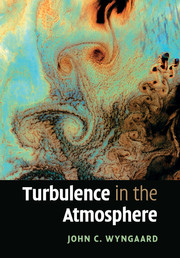Book contents
- Frontmatter
- Contents
- Preface
- Part I A grammar of turbulence
- 1 Introduction
- 2 Getting to know turbulence
- 3 Equations for averaged variables
- 4 Turbulent fluxes
- 5 Conservation equations for covariances
- 6 Large-eddy dynamics, the energy cascade, and large-eddy simulation
- 7 Kolmogorov scaling, its extensions, and two-dimensional turbulence
- Part II Turbulence in the atmospheric boundary layer
- Part III Statistical representation of turbulence
- Index
5 - Conservation equations for covariances
from Part I - A grammar of turbulence
Published online by Cambridge University Press: 11 April 2011
- Frontmatter
- Contents
- Preface
- Part I A grammar of turbulence
- 1 Introduction
- 2 Getting to know turbulence
- 3 Equations for averaged variables
- 4 Turbulent fluxes
- 5 Conservation equations for covariances
- 6 Large-eddy dynamics, the energy cascade, and large-eddy simulation
- 7 Kolmogorov scaling, its extensions, and two-dimensional turbulence
- Part II Turbulence in the atmospheric boundary layer
- Part III Statistical representation of turbulence
- Index
Summary
Introduction and background
We saw in Chapter 1 that direct numerical solutions of the turbulence equations can be done only at relatively small values of the turbulence Reynolds number Rt. Calculations of the vastly larger Rt flows in engineering and geophysical applications use averaged forms of these equations. The averaging produces important turbulent fluxes that must be specified before the equations can be solved numerically. That specification allows today's calculations of averaged turbulence fields in applications ranging from flow in the atmospheric boundary layer to the general circulation of the earth's atmosphere and convection on the sun.
In this chapter we derive, interpret, and scale the conservation equations for several covariances, including turbulent fluxes, that arise from ensemble averaging. At very coarse resolution ergodicity (the property that any unbiased average converges to the ensemble average, Chapter 2) blurs the distinction between ensemble and space averaging, so these covariance equations are used also in traditional mesoscale-modeling and weather-forecasting applications.
Monin and Yaglom (1971) credit a 1924 paper by Keller and Friedmann as the first to present a method of deriving turbulence moment equations, of which the turbulent-flux budgets are an example. Because they contain unknown terms, the turbulence moment equations were little used until the late 1960s, when computers were large enough to solve approximate versions of them.
The literature on models of these flux budgets can be bewildering. The rationale for their closure approximations is not always discussed, and the models go under several names – e.g., “second-order closure,” “Reynolds-averaged Navier–Stokes (RANS),” “single-point closure,” “higher-order closure,” and “invariant modeling.”
- Type
- Chapter
- Information
- Turbulence in the Atmosphere , pp. 89 - 114Publisher: Cambridge University PressPrint publication year: 2010



